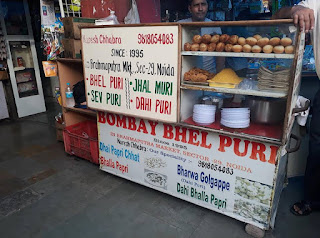When one travels outside Mumbai there is a chance that one may come across a name on a food stall that reads “Bombay Bhel Puri”. Much before Vada Pav became the signature snack of Mumbai, Bhel Puri, or just called bhel was the chaat of choice for Bombayites. It was the go-to snack when outing at a park or beach. The multitude of people eating bhel at Girguam Chowpatty and Juhu beaches are a testimony to this. Over the years many streets in the city had their own bhelwala vending this chaat under a shady tree or a prime corner. Such was the popularity of Bhel Puri in Bombay that the name of the city got associated with it.
The word ‘Chaat’ is derived from the Hindi verb ‘Chaatna’, meaning to lick. And this chaat, like Mumbai’s diverse potpourri of immigrants from all over India, is a mixture of different ingredients, flavours and textures.
One of the earliest vendors of Bhel Puri in Bombay was Vithal Khadawala who came to this city from Surat in 1875, and sold bhel under a tree opposite New Empire Cinema near Victoria Terminus (now CSMT). He operated from there for many years until he was evicted by the Municipal Corporation in 1939, prompting him to move to a rented shop in the vicinity and start his own restaurant, eponymously called Vithal Bhelwala. Whilst Vithal Bhelwala is presently closed, one can sample Vithal’s Bhel next door at the Vithal’s Family Restaurant and Bar run by his descendants.
But, like other chaats, Bhel Puri is best enjoyed at a roadside stall. Besides eating it, the other joy comes from watching the vendor put it together in a paper cone made from pages of discarded magazines. The main ingredient is puffed rice to which he adds sev, crushed puris, diced onions, chopped boiled potatoes, sweet and spicy chutneys, all of which he mixes with a few firm twists of his hand before topping it off with a squeeze of lime, some more sev and finally coriander. Finely diced green mango is a welcome addition. And the way to eat is not with a spoon, but with a puri. This mixture tastes crunchy, soft, sweet, sour, and spicy all in the same bite creating a fusion of flavours in the mouth, and sometimes tears in the eyes which is quickly remedied with a handful of ‘sev-kurmura’ generously dispensed by the bhelwala.
Such are the emotions attached to this chaat that many people prefer to have it from a particular bhelwala, swearing that his bhel is the best in town. But no matter where you have it, this is one snack mixture that will always be connected to the soul of cosmopolitan Mumbai.








